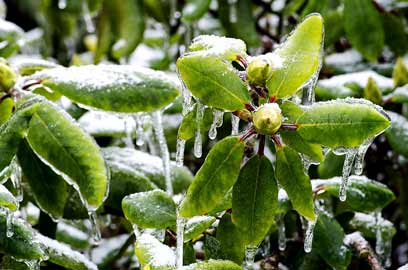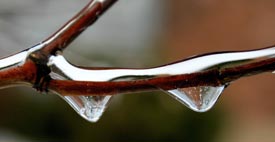It is important to catch ice damage early and take the necessary steps to help your plant maintain health.
If the snow builds up too much on shrub branches, damage can occur. Ice buildup from storms or your roof’s drip line can also occur. If you missed our winter newsletter and the ice has already done its worst, it is important to start the repair process as early as possible.
 Rhododendron bush trapped in ice.
Rhododendron bush trapped in ice.
istock/Thinkstock
As the ice or snow cover melts, check your shrubs carefully. Drooping branches will be the first sign of damage. They may just be bent down and need a gentle nudge to help them perk back up. They could also be broken and need removal. It is also possible the slight damage can be repaired without removal.
The first step is to determine the extent of damage on each branch. Take hold of each drooping branch and follow it back to its origin. If there is no break or tear and another branch or branches are holding it out of place, gently maneuver the branches back into proper position. In most cases, if the branch is broken or torn at its point of origin, it is probably best to remove it. Carefully cut the branch off flush with the origin branch. Make sure that all damaged tissue is removed.
 Heavy accumulations of ice and snow can damage shrubs.
Heavy accumulations of ice and snow can damage shrubs.
Photo courtesy Nicole Lawton
If the branch is broken between its origin and tip, you will still want to cut the branch back to its origin. If another branch, twig or bud is emerging from the damaged branch, you can cut at the point of intersection. Be sure you not to leave stubs sticking out beyond an intersection.
If the branch is not broken all the way through, you may be able to tie it in place and let it heal. Old nylons or other soft ties work best. Monitor the branch for a few weeks. If the branch does not leaf out or grow, it should then be removed. If it does heal and grow, simply remove the tie.
After removing all damaged branches, look over the shape of the shrub and determine if any other pruning is needed to reshape it. Do not cut off more than necessary on spring flowering shrubs. Further pruning can be done after they have bloomed.
All cuts should be clean and almost flush with the preceding branch. You want to cut as close as possible without cutting into that preceding branch. Research shows that wound dressing using pruning paint is unnecessary. The cuts will heal quickest if they are clean and unpainted.